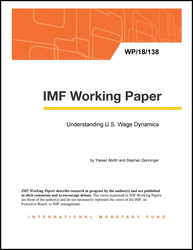
Understanding U.S. Wage Dynamics
In this paper, we undertake empirical analysis to understand U.S. wage behavior since the beginning of the new millennium. At the macroeconomic level, we find that a productivity-augmented Phillips curve model explains the data fairly well. The model reveals that the upward pressure on wage growth from recent tightening in the labor market has been dampened by a persistent decline in trend labor productivity growth and the share of income that accrues to labor. These themes are reinforced and complemented at the micro-economic level. Lower regional unemployment puts an upward pressure on wages of individuals, although this effect has become weaker since 2008. But there is downward pressure on wages for individuals with occupations that are exposed to automation and offshoring, and in industries with a higher concentration of large firms. All these factors appear to play a role illustrating why it is difficult to single out any one culprit for the observed wage growth moderation.
Publication date: June 2018
ISBN: 9781484362082
$18.00
Add to Cart by clicking price of the language and format you'd like to purchase
Available Languages and Formats
| English |
Prices in red indicate formats that are not yet available but are forthcoming.
Topics covered in this book
This title contains information about the following subjects.
Click on a subject if you would like to see other titles with the same subjects.
Wage growth , productivity , slack , routinization , offshoring , globalization
Summary
Copyright © 2010 - 2024
Powered by:
AIDC



